NCLEX QUESTION OF THE DAY
🩺 NCLEX Question of the Day
Question:
A nurse is caring for a client who has just returned from a cardiac catheterization. Which of the following is the highest priority nursing action?
A. Encourage oral fluids to flush out the dye
B. Monitor the catheter insertion site for bleeding
C. Check peripheral pulses in the affected extremity
D. Keep the client on bed rest for 4 to 6 hours
✅ Correct Answer:
C. Check peripheral pulses in the affected extremity
🧠 Rationale:
C. Check peripheral pulses in the affected extremity
→ This is the highest priority because vascular complications (such as an arterial occlusion or thrombus formation) are a serious risk after a cardiac catheterization. Checking peripheral pulses helps to assess adequate blood flow to the limb. Diminished or absent pulses may indicate circulatory compromise, which is a medical emergency.
Explanation of Other Options:
- A. Encourage oral fluids to flush out the dye:
This is important to help excrete the contrast dye and prevent nephrotoxicity, but it is not the most immediate priority. Circulation takes precedence over elimination. - B. Monitor the catheter insertion site for bleeding:
This is also important, but distal circulation assessment takes priority over localized site assessment because an undetected thrombus or arterial occlusion can lead to limb ischemia. - D. Keep the client on bed rest for 4 to 6 hours:
This prevents dislodging of the clot and promotes healing at the insertion site, but it is a routine post-procedure care and not the most urgent concern.
📌 Test-Taking Strategy:
Always use Maslow’s Hierarchy of Needs and ABCs (Airway, Breathing, Circulation). In this scenario, Circulation is the most immediate concern.


